WB realizes new program for strengthening infrastructure in Tajikistan

By Kamila Aliyeva
The World Bank has provided Tajikistan with $50 million to strengthen vital infrastructure to deal with natural disasters in some of the most vulnerable regions.
The Bank reported that a new $50 million project entitled ‘Strengthening Critical Infrastructure Against Natural Hazards’ aims to reconstruct and upgrade critical bridges in the Gorno-Badakhshan Autonomous Oblast (GBAO) in order to improve their resistance to impact from flooding and mudflows.
“In addition to securing important emergency transportation networks, the upgrades will also allow for more fluid traffic and help unlock local economic potential,” the bank said.
This project includes reconstruction and reinforcement of selected river embankments in order to improve river flow in the Khatlon region, increasing household safety, preventing erosion, and decreasing disruptions to farming activities.
The World Bank will also modernize the national crisis management center and emergency communication systems to enable first responders to rapidly access hazard information, generate timely warnings for at-risk communities, and dispatch emergency services more effectively, the bank’s press service reported.
Within the framework of this project it is planned to develop a disaster risk financing strategy for Tajikistan to prepare for efficient financing mechanisms for post-disaster response, recovery and reconstruction as well.
Tajikistan is considered as one of the most climate sensitive countries Central Asia, especially when it comes to climate change.
This Central Asian state is a heavily mountainous region with a population of 8.7 million and a high vulnerability to climate-related issues such as droughts, flooding, landslides, and others.
Tajikistan is the richest country in terms of water resources as about 81 billion cubic meters of water pass through the major rivers annually. Glaciers are the main source of clean drinking water in the region and the most important resources for hydropower stations as well. Over the past 70 years, Tajikistan has lost over 30 percent of its glaciers. Moreover, the disappearance of the Aral Sea has added greater water stresses to this fragile ecosystem.
Almost one third of the Central Asian glaciers are expected to disappear by 2050. This in turn might result in sudden floods. Such disasters are devastating, especially for the countries as Tajikistan, whose agricultural sector employs about 60 percent of total population. Moreover, the key transport infrastructure might be washed away taking long time for further restoration.
Earlier, in 2015, high temperatures have already caused flooding and mudflows which damaged the important infrastructure, forced about 10,000 people to evacuate and knocked out electricity.
Therefore, Tajikistan is constantly threatened by possible disasters and climate risks.
The WB emphasizes that, since 1999, Tajikistan has managed to reduce its poverty rates by half. However, over the past 25 years, there has also been a series of major disasters, which together led to economic losses of over $1.8 billion and affected more than 80 percent of the population.
---
Kamila Aliyeva is AzerNews’ staff journalist, follow her on Twitter: @Kami_Aliyeva
Follow us on Twitter @AzerNewsAz
Here we are to serve you with news right now. It does not cost much, but worth your attention.
Choose to support open, independent, quality journalism and subscribe on a monthly basis.
By subscribing to our online newspaper, you can have full digital access to all news, analysis, and much more.
You can also follow AzerNEWS on Twitter @AzerNewsAz or Facebook @AzerNewsNewspaper
Thank you!
